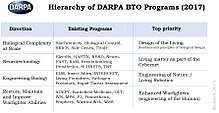Biological Technologies Office (DARPA)

The Biological Technologies Office (BTO) is one of the seven technical offices within DARPA, an agency of the U.S. Department of Defense that is responsible for the development of advanced technology for national security. BTO was created in 2014 by combining some programs from the Defense Sciences Office (DSO) and the Microsystems Technology Office (MTO).[1] The office focuses on basic and applied research in the areas of gene editing, biotechnologies, neurosciences and synthetic biology — from powered exoskeletons for soldiers to brain implants that can control mental disorders.[2][3]
DARPA’s embrace of bioscience began in earnest in 2001, when anthrax spores posted to media offices and members of the US Congress brought concerns about bioterrorism to the fore. Then came the wars in Afghanistan and Iraq, which led the agency to invest in fields such as neuroscience, psychology and brain-computer interfaces — all with the intention of helping injured veterans. By 2013, the number of biology-related programmes had grown such that DARPA decided to consolidate them under one roof.[2]
Organization
The first BTO office director in 2014-2015 - Dr. Geoffrey Ling, MD.[4]
The current BTO office director is Dr. Justin Sanchez, who joined DARPA as program manager in 2013 and was named director in 2015.
Active Programs
The BTO focused on leveraging advances in engineering and information sciences to drive and reshape biotechnology for technological advantage. BTO is responsible for all neurotechnology, human-machine interface, human performance, infectious disease, and synthetic biology programs within the agency.[5]
- Autonomous Diagnostics to Enable Prevention and Therapeutics (ADEPT)
- Battlefield Medicine
- Biochronicity
- Biological Control
- Biological Robustness in Complex Settings (BRICS)
- Dialysis-Like Therapeutics (DLT)
- Electrical Prescriptions (ElectRx)
- Engineered Living Materials (ELM)
- Hand Proprioception and Touch Interfaces (HAPTIX)
- In Vivo Nanoplatforms (IVN)
- Insect Allies
- INTERfering and Co-Evolving Prevention and Therapy (INTERCEPT)
- Living Foundries
- Microphysiological Systems (MPS)
- Neural Engineering System Design (NESD)
- Neuro Function, Activity, Structure, and Technology (Neuro-FAST)
- Pandemic Prevention Platform (P3)
- Pathogen Predators
- Prometheus
- Prophecy (Pathogen Defeat)
- Rapid Threat Assessment
- Restoring Active Memory (RAM)
- Revolutionizing Prosthetics
- Safe Genes
- Strategic Social Interaction Modules (SSIM)
- Systems-Based Neurotechnology for Emerging Therapies (SUBNETS)
- Targeted Neuroplasticity Training (TNT)
- Technologies for Host Resilience (THoR)
- Warrior Web
- Wound Stasis System (WSS)
References
- ↑ Klabukov, Ilya; Alekhin, Maksim; Nekhina, Anastasiya (2014). "Review of DARPA FY 2015 Research Programs". Innovation Practice eJournal. Rochester, NY. 2 (11). doi:10.2139/ssrn.2439081.
- 1 2 Reardon, Sara (2015). "The military-bioscience complex". Nature. 522 (7555): 142–144. doi:10.1038/522142a. PMID 26062493.
- ↑ Laursen, Lucas (2014-06-09). "DARPA redesign". Nature Biotechnology. 32 (6): 509–509. doi:10.1038/nbt0614-509.
- ↑ "Straight talk with...Geoffrey Ling". Nature Medicine. 20 (6): 570–570. 2014. doi:10.1038/nm0614-570.
- ↑ "Biological Technologies Office of the DARPA". DARPA.
